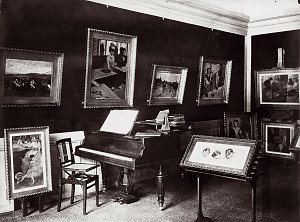Isaac de Camondo, Moïse’s first cousin and his elder by nine years, was born in Constantinople in 1851. He arrived in France with his parents at the age of eighteen. He was involved in the family business at an early age, becoming the bank’s agent then General Consul of Turkey from 1891 to 1895 – and thus a prime link between his family and the Ottoman power. From 1894 he began to distance himself from the world of finance to allow his artistic side to flourish.
As a musician he was fascinated by Wagner, and composed a number of works including an opera called Le Clown (1906). Having many connections in the music world, he helped his friend Gabriel Astruc to realize his projects – notably his plans for the Théâtre des Champs-Elysées.

The Degas room in Isaac de Camondo’s house, 82 avenue des Champs-Elysées, c. 1910
© MAD, Paris
It was above all as a collector that Isaac made his name, however. His tastes were eclectic; with his fascination for the Far East and passion for Japonisme, he assembled a collection of sculptures, lacquers and ceramics and an impressive series of prints. In 1880, he made the most remarkable purchases at the sale of Baron Double (a prominent collector of eighteenth-century art): a large number of tables, chest of drawers and seats, and the auction’s star piece: the famous Three Graces clock. On the advice of his curator friends, he later collected medieval and Renaissance sculptures. He was also a fervent champion of the Impressionists; he greatly admired Degas and owned some thirty of his works. Though he had little contact with the latter, he was very friendly with Monet whom he sometimes visited at Giverny.
At his death in 1911, his collection was bequeathed to the Louvre on the condition that it should be exhibited for fifty years in a series of rooms named after him. A hundred Impressionist paintings, pastels and drawings – including Manet’s Fife Player, Degas’s Tub, Monet’s Rouen Cathedrals and Cézanne’s Hanged Man’s House – thus made their sensational and controversial entrance into the museum.
By the end of World War II the fifty-year period was almost over and the works donated by Isaac were presented in different departments of the Louvre, such as the Department of Decorative Arts (where a room is still named after the great donor), and in the Musée Guimet and the Jeu de Paume; some are now in the Musée d’Orsay, the Château de Versailles and the Musée de la Marine.